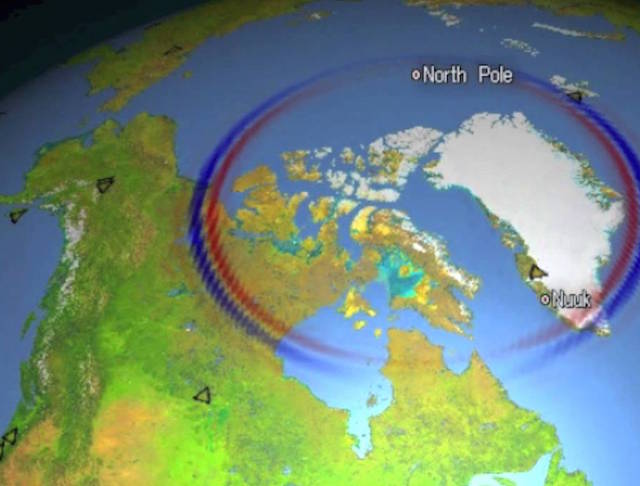Do Solar Flares Trigger Earthquakes?
First let us pose the science question we wish to answer: do solar flares cause earthquakes? Note that this is more specific than asking ‘is there a relationship between solar activity and earthquakes?’. First of all, solar activity can mean flares, or coronal mass ejections, or bursts of solar wind. Here I will focus only on flares, but do bear in mind that flares and CMEs often occur in tandem. Secondly, we are asking if flares CAUSE earthquakes; not whether a LACK of flares cause earthquakes. If flares do indeed cause earthquakes then we would expect to see a positive correlation between flares occurring and earthquakes occurring. If a lack of flares cause earthquakes, then we would expect a negative (or anti-) correlation.
For this experiment I have downloaded data from all known earthquakes from 1980 to the present day. This data is publicly available from the United States Geological Survey website (USGS). Here I must point out that I am not a seismologist – I have merely gathered together the dates and magnitudes of all known earthquakes greater than 4 on the Richter scale from the past 30 years. A list of all the solar flares from the last 30 years is also available from NOAA’s National Geophysical Data Center (NGDC). Below is the plot I made which shows the occurrence rate of both solar flares (in blue) and earthquakes (in red). (Anyone with a basic understanding of Excel, a little curiosity, and a bit of patience, can try this for themselves.) You can see that solar flares come and go with each solar cycle (approximately every 11 years), whereas earthquakes appear to occur continuously, with no obvious pattern. There are large (magnitude>7) earthquakes both at solar maximum and solar minimum. This to me would be evidence enough that flares and earthquakes are not related. But let us go a step further. What would something that IS correlated with solar activity look like?

The occurrence rate of both solar flares (in blue) and earthquakes (in red). (Click on Image to See A Larger Version)
What would something that IS correlated with solar activity look like?
For the next plot, I have gathered together data on the appearance of sunspots over the same 30 year period (http://www.ngdc.noaa.gov/stp/solar/ssndata.html; I happen to have access to a lot of solar data!). By overlaying the occurrence of solar flares on this plot, we can clearly see that the number of flares rises and falls with the number of sunspots (the orange curve), again every 11 years or so. I would call this a pretty strong case for proving that flares are in someway related to sunspots (which of course we know they are, as we can see flares occurring in regions of intense magnetic field on the Sun).

The occurrence rate of both solar flares (in blue) and sunspots (in red). (Click on Image to See A Larger Version)
I have also been looking at data on ionospheric disturbances here on earth as part of my own research (again, this data is publicly available via the Stanford University website http://sid.stanford.edu/database-browser/). I selected a day in which I knew there was significant solar activity (in this case, 18 February 2011) and plotted the solar activity for that day (top panel) against the corresponding changes in the upper atmosphere above Austria (bottom panel). This clearly shows that at least five of the flares that day (denoted by the vertical dashed red lines) had a direct impact on the ionosphere. Again, this suggests a causal relationship between solar activity and atmospheric disturbances; something not seen in the earthquake data.

The flare solar activity for 18 February 2011 (top panel) plotted against the corresponding changes in the ionosphere above Austria (bottom panel).
But these are large-scale statistical studies. What if there was one ‘perfect solar storm’ that happened to slip through the net? Would that then have any geological effects? Well, what is a solar flare exactly? The data I have used in the above plots are from X-ray sensors onboard the GOES series of satellites. So flares are essentially just that; increases in X-ray emission (and sometimes gamma-rays). There is, of course, increased emission from across the spectrum: radio, optical, UV, and infrared. Thankfully, the Earth’s atmosphere protects us by absorbing the vast majority of this radiation, as shown by the plot of ionospheric disturbances above. The only solar emission that makes it to the surface is visible light that we can see with our eyes, and radio emission (see figure below). So barely any of this X-ray light makes it through the atmosphere, let alone to beneath the surface to where earthquakes occur. Similarly, CMEs are essentially clouds of charged particles which get deflected by our magnetic field and rarely make it to the surface. And given that the Earth’s magnetic field has a strength similar to that of a household fridge magnet, any fluctuations caused by a CME impact cannot influence the motion of tectonic plates which carry entire continents!

This shows the what wavelengths of electromagnetic radiation can penetrate Earth’s atmosphere and what wavelengths are stopped by the atmosphere.
Of course, there are more sophisticated data analysis techniques and correlation tracking algorithms available compared to that which I have presented here. So if you feel that my rather simplistic approach has failed to reveal a potential relationship between solar and geological activity, then I urge you to sift through the data for yourself. This is how science works, which is why I have included links to the pages where I obtained my data so you may repeat the experiment for yourself if you choose, in order to verify or refute my conclusions. But simply noting that a solar flare and an earthquake occurred together within a short time frame does not imply that one caused the other. In the words of renowned astronomer Richard Carrington, “One swallow does not a summer make”.*Finally, as solar activity continues to increase during the rise of the current solar cycle, expected to peak around 2013, here is a statement from the USGS themselves on whether earthquakes are really on the increase or not as well (http://earthquake.usgs.gov/learn/topics/increase_in_earthquakes.php):
We continue to be asked by many people throughout the world if earthquakes are on the increase. Although it may seem that we are having more earthquakes, earthquakes of magnitude 7.0 or greater have remained fairly constant.
A partial explanation may lie in the fact that in the last twenty years, we have definitely had an increase in the number of earthquakes we have been able to locate each year. This is because of the tremendous increase in the number of seismograph stations in the world and the many improvements in global communications. In 1931, there were about 350 stations operating in the world; today, there are more than 8,000 stations and the data now comes in rapidly from these stations by electronic mail, internet and satellite. This increase in the number of stations and the more timely receipt of data has allowed us and other seismological centers to locate earthquakes more rapidly and to locate many small earthquakes which were undetected in earlier years. The NEIC now locates about 20,000 earthquakes each year or approximately 50 per day. Also, because of the improvements in communications and the increased interest in the environment and natural disasters, the public now learns about more earthquakes.
According to long-term records (since about 1900), we expect about 17 major earthquakes (7.0 – 7.9) and one great earthquake (8.0 or above) in any given year.
*Mr Carrington made this reference after observing the great solar flare of 1 September 1859, and then noting that the magnetometers at Kew Gardens had gone haywire a day later “as if the earth had been struck by a magnetic fist”. We now understand that this was due to a CME impacting the earth’s magnetic field, but at the time Mr Carrington was urging caution in drawing a direct comparison between the two phenomena without further detailed analysis of the data: just because you see a swallow one day, it does not mean that summer has arrived. SOURCE




